

Young Dark Emu - videos by Bruce Pascoe - Chapter-by-Chapter. In 2014, Bruce Pascoe wrote a book called Dark Emu that challenged the belief that the First Australians were hunter-gatherers.
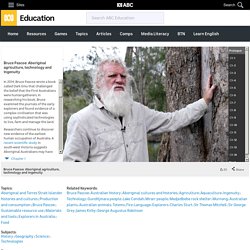
In researching his book, Bruce examined the journals of the early explorers and found evidence of a complex civilisation that was using sophisticated technologies to live, farm and manage the land. Researchers continue to discover new evidence of the earliest human occupation of Australia. A recent scientific study in south-west Victoria suggests Aboriginal Australians may have been living on the continent for 120,000 years. Australians Together. Connection to Country For many Indigenous people, land relates to all aspects of existence - culture, spirituality, language, law, family and identity.
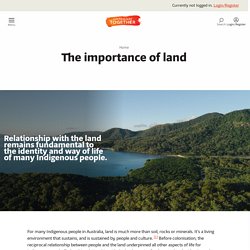
Rather than owning land, each person belongs to a piece of land which they’re related to through the kinship system. That person is entrusted with the knowledge and responsibility to care for their land, providing a deep sense of identity, purpose and belonging. Welcome to and Acknowledgement of Country. Welcome to Country is an ancient Indigenous tradition that was practiced when one Indigenous community sought permission to enter another clan’s traditional land.

The ceremony varied from clan to clan. Joy Murphy Wandin describes Welcome to Country as it was practiced by her people, the Wurundjeri: “When there was a request to visit Country, the Werrigerri (a young man selected by the Elders of the community) would go on behalf of the community under the voice of the Elder, the Nurungeeta. AIATSIS map of Indigenous Australia. Move your cursor over any area of the map to reveal the 'magnifying glass' circle.
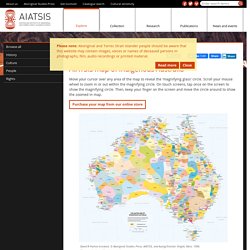
Scroll your mouse wheel to zoom in or out within the magnifying circle. On touch screens, tap once on the screen to show the magnifying circle. First Australians – Episode 1, They Have Come to Stay (2008) clip 1 on ASO. Clip description Narrator Rachel Perkins re-tells stories from the Dreamtime and historian Professor Marcia Langton of the Yiman-Bidjara Nation, historian Professor Janet McCalman and writer Bruce Pascoe of Boonwurrung Heritage weigh in on the unique prehistory experience of Australian Indigenous peoples.
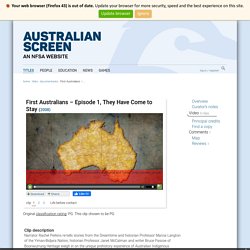
Curator’s notes The images of the Australian landscape are breathtaking as Perkins recounts the Dreamtime stories. Before Time - Aboriginal history - My Place. Indigenous Australian belief systems explain that creator ancestral beings gave birth to the people, and also shaped the lands and waterways, giving them spiritual significance.
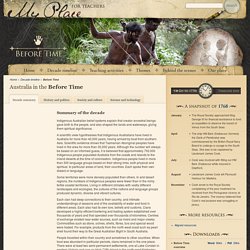
A scientific view hypothesises that Indigenous Australians have lived in Australia for more than 40,000 years, having arrived by boat from southern Asia. Scientific evidence shows that Tasmanian Aboriginal peoples have lived in the area for more than 30,000 years. Although the number will always be based on an informed guess, it is believed that approximately 750,000 Indigenous people populated Australia from the coasts and islands to the inland deserts at the time of colonisation. Indigenous people lived in more than 300 language groups based on their strong links, both physical and spiritual, to particular areas of land, their countries. Aboriginal Dreamtime Stories. IMAGE: Aborigines using fire to hunt kangaroos by Joseph Lycett, approximately 1775-1828. - Bush Telegraph - ABC Radio National (Australian Broadcasting Corporation) Australians Together. Kinship is at the heart of Indigenous society.
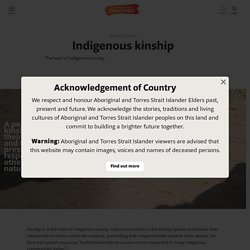
A person’s position in the kinship system establishes their relationship to others and to the universe, prescribing their responsibilities towards other people, the land and natural resources. Family and kinship. Birthing on Country - sbs.com. Many women don’t have the opportunity to birth on country, either because there are no maternity services available in their region or they have pregnancy complications.

So there’s the opportunity for what we call ‘birthing off country’. One midwife working in a large tertiary maternity service told me about assisting with the birthing for a woman who had been transferred from a remote region due to complications. English wasn’t her first language, but she had family with her that could explain. Labour & Birth page 94 - Traditional Aboriginal birthing Practices in Australia byHelenCallaghan. Introduction to Indigenous Australia. Australia has always had a mix of cultures and people although not in the same way as it does today.
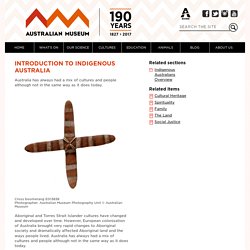
Cross boomerang E013838 Photographer: Australian Museum Photography Unit © Australian Museum Aboriginal and Torres Strait Islander cultures have changed and developed over time. AIATSIS map of Indigenous Australia. Eora - Mapping Aboriginal Sydney 1770-1850. Eora This is a story of the Eora, created through a close and innovative interrogation of the European records of early colonisation.

Eora - Intro It is customary for some Indigenous communities not to mention names or reproduce images associated with the recently deceased. Indigenous Australian Languages. Celebrating 2019 International Year of Indigenous Languages Strong cultural identity enables one to feel proud of themselves, and speaking and maintaining ones language raises self-esteem and enables one to feel good about themselves.
Traditional language is important for maintaining strong cultural connections. Where traditional languages have been taken away from communities, a sense of loss, grief and inadequacy develops. To keep communities and generations strong, traditional language being passed from one generation to another is vital. Brooke Joy, descendant of Boandik people from the Mount Gambier region in South Australia (Community, identity, wellbeing: The report of the Second National Indigenous Languages Survey, 2014)
Aboriginal history. Barani Barani is an Aboriginal word of the Sydney language that means 'yesterday'. The Barani website examines the histories of people, places and events associated with Sydney's Aboriginal and Torres Strait Islander peoples. What is Bush Food? A Brief Aboriginal History. “The very ink with which all history is written is merely fluid prejudice.” Mark Twain Since the European invasion of Australia in 1788, the Aboriginal people have been oppressed into a world unnatural to their existence for thousands of years.
First came the influx of the strangers who carried with them diseases, which decimated the immediate population of the Sydney tribes. Top 10 Aboriginal bush medicines. THE CHINESE DRANK tea from sweet wormwood leaves to cure chills and fevers, Egyptians used a herb from a plant called khella to help pass kidney stones, and all around the world, leeches were placed on sores to stop blood from clotting. While these traditional methods of treatment are well known natural cures, Australian bush medicine, much like the bush itself is still very much a mystery. "A lot of information is lost," says Dr Evelin Tiralongo a pharmacist and expert in complementary medicine from Griffith University in Queensland.
"[In Aboriginal culture], nothing is written down; instead, it's passed on through singing and dancing ceremonies, which are becoming increasingly rare. " According to Evelin most Aboriginal medical treatments were derived from food. "A big part of maintaining their health was just eating right," she says. Eucalyptus leaves can be infused for body pains and fevers and chills. 1. Aboriginal bush medicines. Endeavour Journal - Indigenous Studies, History. Endeavour Journal is an episode of the series National Treasures produced in 2004. Endeavour JournalWhat is Australia’s greatest book? In the National Library of Australia there is a 743-page volume that could lay claim to the title. It is Lieutenant James Cook’s journal, written on board the Endeavour during his trip down under in 1770. Warren Brown leafs through these precious pages to discover Cook’s first impressions and trace the beginning of Australia as we know it today.
National TreasuresTake a road-trip of discovery with the irrepressible Warren Brown – political cartoonist, columnist and history “tragic” – as he reveals a fascinating mix of national treasures drawn from public and private collections across Australia. National Treasures is a Film Australia National Interest Program. Captain James Cook FRS RN (October 27, 1728 – February 14, 1779) was an English explorer, navigator and cartographer. Aboriginal people and place - Barani. Aboriginal Culture. Australian Aborigines manufactured a range of tools, utensils, fighting weapons, and hunting weapons made from the available resources of wood, bone and shell. Aboriginal Use of Rocks and Minerals: Melbourne Museum.
Explore cultural objects, art & technology - The Australian Museum. Sell aboriginal weapons. Explore cultural objects, art & technology. Aboriginal toys. In 1905, the museum acquired around 30 toys originally collected by Walter Edmund Roth, from Cape York and Channel Country in Queensland several years earlier. North-west NSW Aboriginal artefacts. Australian Aboriginal history timeline. <img src="/images/uploads/aboriginalculture/history/rottnest-island-beach-western-australia.jpg" width="432" height="288" alt="Rottnest Island, WA"/>Rottnest Island, Western Australia. Aboriginal people saw the island when it was still connected to the mainland. Aboriginal history timeline (1400 - 1769) How to talk to someone who is on the fence on changing Australia Day?
The Guardian has published a short, humorous guide abou…Tonight: "Salute" celebrates a historical moment few know aboutDon't know Peter Norman? You're not alone. Most Australians h…Need an engaging & informative resource? Indigenous Australia Timeline - Pre-Contact. Indigenous Australia Timeline - 1500 to 1900. National Museum of Australia.